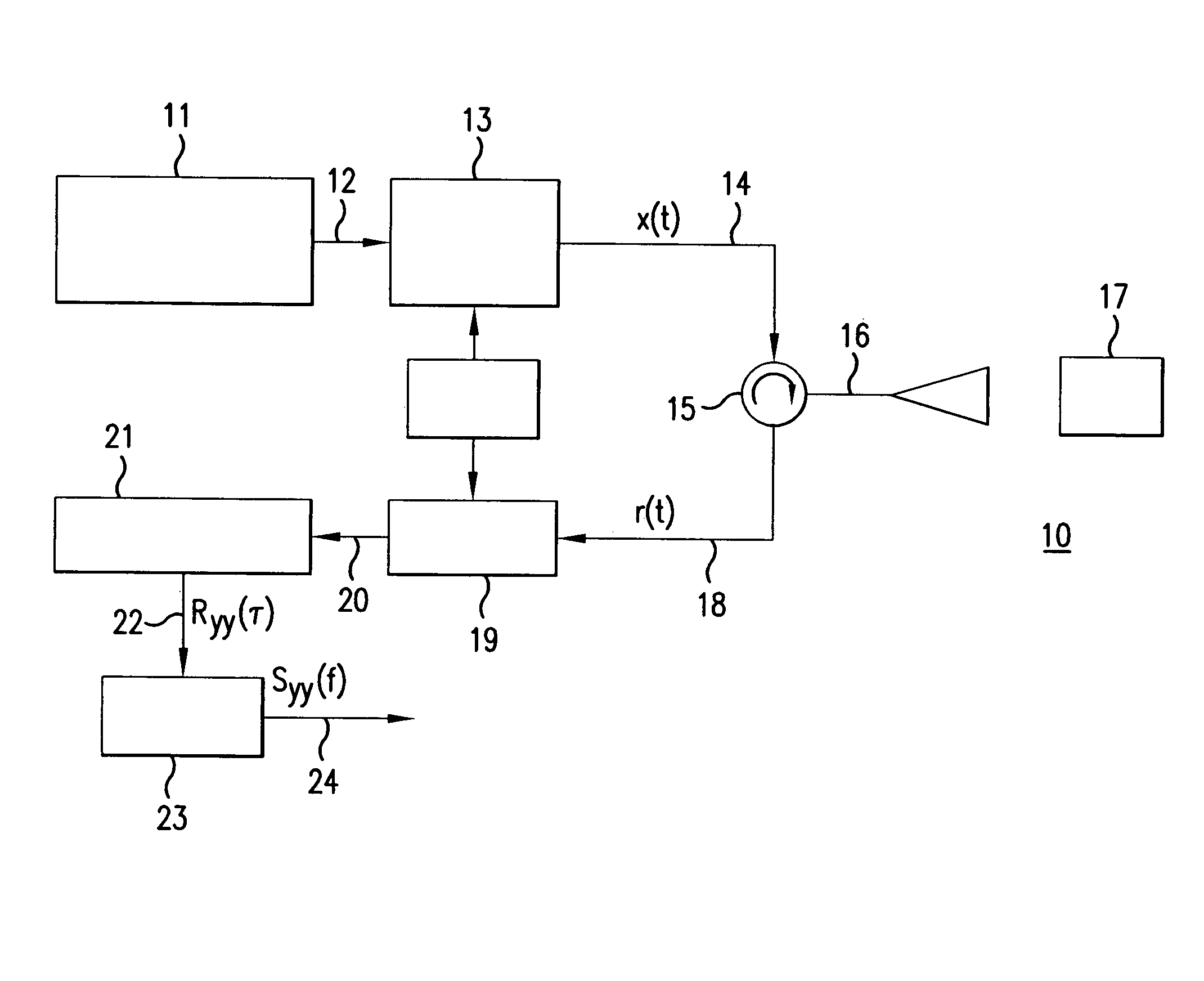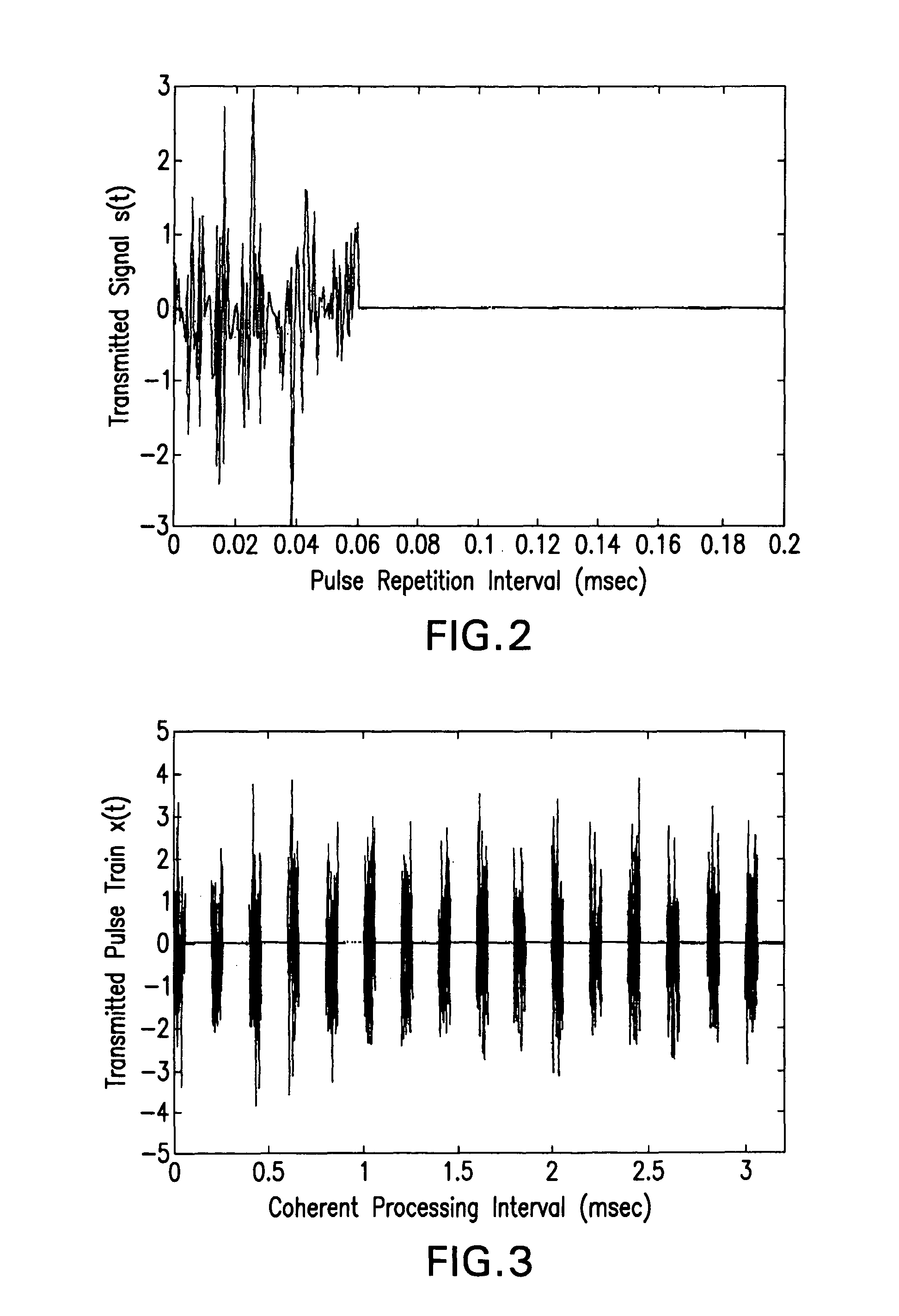[0013]In order to overcome the disadvantages, shortcomings and limitations of prior art radar target detection, such as costly and sluggish hardware, waveform disadvantages such as centering the carrier
frequency response, increasing the probability of detection, and the life-threatening risks of unwanted detection, the pulsed noise correlation radar apparatus of the present invention advantageously uses
pulse compression technology, a pulsed linear frequency modulated noise correlation mixer, and a new and innovative noise fused waveform to automatically correlate the pulsed linear frequency modulated noise waveform with the received signal. This eliminates the need for injecting a delayed reference
signal correlation. This invention's pulsed noise correlation radar apparatus and
system now make it possible to effectively reduce transmitting power, preserve high band widths through
oversampling in the
receiver, and achieve multi-channel array frequency diversity. This invention's pulsed compression waveform structure with correlated noise radar offers designers and users the choice of reducing
processing burdens on
system hardware while still preserving the random signal structure and its associated amenities. One essential difference between the prior art and this invention's noise correlation radar is this invention's unique fused waveform, particularly, the linear
frequency modulation which allows the pulsed noise correlation radar to take
advantage of correlation mixing that allows it to optimally and efficiently detect targets.
[0017]These and other objects and advantages are achieved by this invention's pulsed noise correlation radar apparatus comprising a
Gaussian noise
signal generator, a frequency modulator generating a pulse
train and linear frequency modulated (LFM) noise waveform, a means for sensing targets, a frequency demodulator, and a Transform of a correlated signal y(t) that generates a Y(jω) signal, calculates power
spectral density Syy(jω) and generates a pulse compression LFM waveform. Preferably a
Fast Fourier Transform can be used according to one embodiment of the invention. The pulse compression LFM noise waveform generated by the pulsed noise correlation radar apparatus rapidly increases its carrier frequency, achieves instantaneous band widths, and better detects a target without being intercepted or detected. Unlike the prior art's cumbersome and time-consuming use of optical
delay lines or matched-filter banks, this invention's unique pulsed fused LFM noise waveform uses correlation mixing to optimally and more efficiently detect targets.
[0018]The present invention takes
advantage of several aspects of pulsed signals to substantially improve radar target detection in military surveillance systems focused on detecting single or multiple targets at extended ranges. The fact that the waveform is pulsed allows the timing control associated with the transmission of successive, coherent pulses to be managed and maintained thereby reducing any isolation faults between the transmission and the reception process. As a result, the same antenna
phase center can be used, which makes potential
hardware implementations more practical. Furthermore, this synchronization allows for a
ranging capability that can be directly defined by the equation:Ru=c(T / 2) Equation (1)where Ru is the unambiguous range, c is the
speed of light, and T is the pulse repetition interval.
[0019]Equation (1) makes it clear that when a target is present, a
delay will naturally manifest itself in the returned signal structure. Furthermore, pulsed signals are able to incorporate pulse compression techniques thereby minimizing the burden on the
transmitter /
receiver when trying to realize
high bandwidth, and their associated narrow pulse widths, for
high resolution applications.
Pulse compression also maximizes the transmit duty factor keeping the
effective radiated power low, as one would expect with a fundamental UWB signal. Lastly, because the pulsed LFM noise transmit signal is stored as a reference, the correlation mixer can be incorporated into the receive side in order to resolve discrete frequency responses induced by the time dilation effect caused by the target's
scintillation (reflection,
refraction,
diffraction) thereby eliminating the need to inject a delayed reference signal through the use of an
optical delay line.
[0020]It is important to note that the pulsed noise correlation radar and its unique pulsed LFM fused noise waveform exhibit an extremely low probability of being intercepted and a low probability of detection that is highly desired in numerous military and commercial applications. Furthermore, because of the ultra-
wide band characteristics of the waveform, the receiver will be practically immune to interference and channel
fading typically associated with
narrow band signals. Since a pulsed signal is generated, the designer may also introduce frequency diversity with a multi-channel array thereby introducing spatial and temporal
degrees of freedom exponentially more powerful than a
single phase antenna.
[0021]This invention provides a pulsed noise correlation radar apparatus that answers the long-felt need for a pulse compression radar system to overcome the disadvantages, shortcomings, and limitations of prior art
radar systems. In accordance with the present invention, both radar
target acquisition and high bandwidths are preserved through
oversampling, multi-channel array frequency diversity, and substantially increased user security without suffering from the disadvantages, shortcomings, and limitations of prior art devices. The present invention also encompasses a secure pulsed compression noise correlation radar system and methods for undetected target detection with pulsed noise correlation radar and a pulsed LFM fused noise waveform.
 Login to View More
Login to View More  Login to View More
Login to View More 


